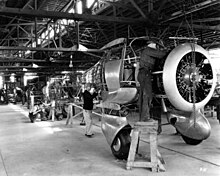Beech Aircraft
D17S Staggerwing
|
|||||||||||||||||||||
|
|
|
|---|
.
History Beech Aircraft Corporation
Beechcraft D17S Staggerwing

In 1932, Walter H. Beech, formerly head of the aircraft manufacturer Travel Air, left Curtiss-Wright, which had purchased Travel Air in 1929, to set up a new company, Beech Aircraft Corporation, based in Wichita, Kansas. Beech took the airplane designer Ted A. Wells from Curtiss-Wright, and the first project of the new company was the Model 17, a fast biplane with an enclosed cabin designed to meet the needs of business executives. It was based on a design drafted by Wells while at Curtiss-Wright, but rejected by the Curtiss-Wright board. The Beechcraft Model 17, popularly known as the "Staggerwing", was first flown on November 4, 1932. During its heyday, it was used as an executive aircraft, much as the private jet is now, and its primary competition were the Waco Custom Cabin and Waco Standard Cabin series of biplanes.
Design and development


Air Racing
Sales began slowly. The first Staggerwings' high price tag (between US$14,000 and $17,000, depending on engine size) scared off potential buyers in an already depressed civil aircraft market. Only 18 Model 17s were sold during 1933, the first year of production, but sales steadily increased. Each Staggerwing was custom-built by hand. The luxurious cabin, trimmed in leather and mohair, held up to five passengers. Eventually, the Staggerwing captured a substantial share of the passenger aircraft market. By the start of World War II, Beechcraft had sold more than 424 Model 17s.

Photo Gallery
Beech Aircraft Corporation
Beechcraft D17S Staggerwing


Beech Aircraft Corporation
Beechcraft D17S Staggerwing
General Info
-
-
-
- Crew: one
- Capacity: three or four passengers plus 125 lb (56.7 kg) baggage
- Length: 26 ft 10 in (8.18 m)
- Wingspan: 32 ft (9.8 m)
- Height: 8 ft (2.4 m)
-
-
Powerplant
-
- Empty weight: 2,540 lb (1,152 kg)
- Gross weight: 4,250 lb (1,928 kg)
- Powerplant: 1 × Pratt & Whitney R-985-AN-1 "Wasp Junior" radial engine, 450 hp (340 kW) at 2,300 rpm
Performance
- Maximum speed: 212 mph (341 km/h
- Cruise speed: 202 mph (325 km/h,
- Range: 670 mi (1,078 km, 582 nmi)
- Service ceiling: (7,600 m)
- Rate of climb: 1,500 ft/min (7.6 m/s)
.
Links to Youtube & Others
World War II
In March 1942, The Beech Aircraft Company Began Design Work On A Two-Seat Heavy Fighter To Destroy Enemy Bombers. Since The Curtiss XP-71 Had Already Been Delegated This Task, The Beech Developed The Design Into An Attack Aircraft To Replace The Douglas A-20 Havoc.
Beechcraft Aircraft
Beechcraft Staggerwing
The XA-38 Was A Two-Place, Mid-Wing Aircraft With A Slim Fuselage And Twin Tails
Youtube Link
The Grizzly’s Aluminum Skin Was Entirely Flush Riveted, And The Fully Retractable Gear, Including Tailwheel, Was Engineered For Operations Out Of Unimproved Airstrips.











.png)



